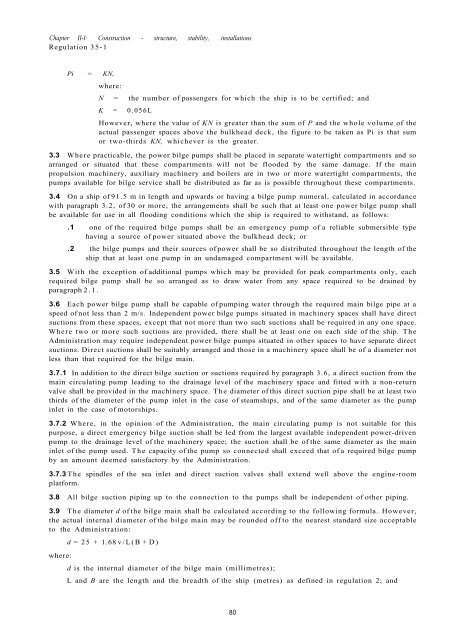Solas Consolidated Edition 2009.pdf
Solas Consolidated Edition 2009 for maritime
Solas Consolidated Edition 2009 for maritime
Create successful ePaper yourself
Turn your PDF publications into a flip-book with our unique Google optimized e-Paper software.
Chapter II-l: Construction - structure, stability, installations<br />
Regulation 35-1<br />
Pi = KN,<br />
where:<br />
N = the number of passengers for which the ship is to be certified; and<br />
K = 0.056L<br />
However, where the value of KN is greater than the sum of P and the whole volume of the<br />
actual passenger spaces above the bulkhead deck, the figure to be taken as Pi is that sum<br />
or two-thirds KN, whichever is the greater.<br />
3.3 Where practicable, the power bilge pumps shall be placed in separate watertight compartments and so<br />
arranged or situated that these compartments will not be flooded by the same damage. If the main<br />
propulsion machinery, auxiliary machinery and boilers are in two or more watertight compartments, the<br />
pumps available for bilge service shall be distributed as far as is possible throughout these compartments.<br />
3.4 On a ship of 91.5 m in length and upwards or having a bilge pump numeral, calculated in accordance<br />
with paragraph 3.2, of 30 or more, the arrangements shall be such that at least one power bilge pump shall<br />
be available for use in all flooding conditions which the ship is required to withstand, as follows:<br />
.1 one of the required bilge pumps shall be an emergency pump of a reliable submersible type<br />
having a source of power situated above the bulkhead deck; or<br />
.2 the bilge pumps and their sources of power shall be so distributed throughout the length of the<br />
ship that at least one pump in an undamaged compartment will be available.<br />
3.5 With the exception of additional pumps which may be provided for peak compartments only, each<br />
required bilge pump shall be so arranged as to draw water from any space required to be drained by<br />
paragraph 2.1.<br />
3.6 Each power bilge pump shall be capable of pumping water through the required main bilge pipe at a<br />
speed of not less than 2 m/s. Independent power bilge pumps situated in machinery spaces shall have direct<br />
suctions from these spaces, except that not more than two such suctions shall be required in any one space.<br />
Where two or more such suctions are provided, there shall be at least one on each side of the ship. The<br />
Administration may require independent power bilge pumps situated in other spaces to have separate direct<br />
suctions. Direct suctions shall be suitably arranged and those in a machinery space shall be of a diameter not<br />
less than that required for the bilge main.<br />
3.7.1 In addition to the direct bilge suction or suctions required by paragraph 3.6, a direct suction from the<br />
main circulating pump leading to the drainage level of the machinery space and fitted with a non-return<br />
valve shall be provided in the machinery space. The diameter of this direct suction pipe shall be at least two<br />
thirds of the diameter of the pump inlet in the case of steamships, and of the same diameter as the pump<br />
inlet in the case of motorships.<br />
3.7.2 Where, in the opinion of the Administration, the main circulating pump is not suitable for this<br />
purpose, a direct emergency bilge suction shall be led from the largest available independent power-driven<br />
pump to the drainage level of the machinery space; the suction shall be of the same diameter as the main<br />
inlet of the pump used. The capacity of the pump so connected shall exceed that of a required bilge pump<br />
by an amount deemed satisfactory by the Administration.<br />
3.7.3 The spindles of the sea inlet and direct suction valves shall extend well above the engine-room<br />
platform.<br />
3.8 All bilge suction piping up to the connection to the pumps shall be independent of other piping.<br />
3.9 The diameter d of the bilge main shall be calculated according to the following formula. However,<br />
the actual internal diameter of the bilge main may be rounded off to the nearest standard size acceptable<br />
to the Administration:<br />
where:<br />
d = 25 + 1.68 v/L(B + D)<br />
d is the internal diameter of the bilge main (millimetres);<br />
L and B are the length and the breadth of the ship (metres) as defined in regulation 2; and<br />
80


